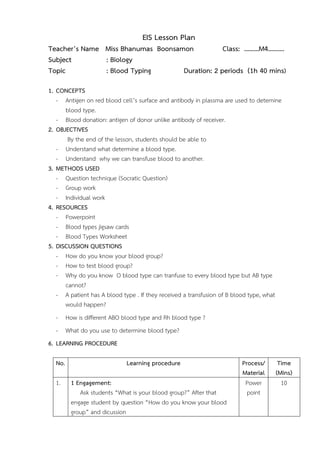
Blood type lesson plan
- 1. EIS Lesson Plan Teacher’s Name Miss Bhanumas Boonsamon Class: ………M4………. Subject : Biology Topic : Blood Typing Duration: 2 periods (1h 40 mins) 1. CONCEPTS - Antigen on red blood cell’s surface and antibody in plassma are used to detemine blood type. - Blood donation: antigen of donor unlike antibody of receiver. 2. OBJECTIVES By the end of the lesson, students should be able to - Understand what determine a blood type. - Understand why we can transfuse blood to another. 3. METHODS USED - Question technique (Socratic Question) - Group work - Individual work 4. RESOURCES - Powerpoint - Blood types jigsaw cards - Blood Types Worksheet 5. DISCUSSION QUESTIONS - How do you know your blood group? - How to test blood group? - Why do you know O blood type can tranfuse to every blood type but AB type cannot? - A patient has A blood type . If they received a transfusion of B blood type, what would happen? - How is different ABO blood type and Rh blood type ? - What do you use to determine blood type? 6. LEARNING PROCEDURE No. Learning procedure Process/ Material Time (Mins) 1. 1 Engagement: Ask students “What is your blood group?” After that engage student by question “How do you know your blood group” and dicussion Power point 10
- 2. No. Learning procedual Process/ Material Time 2. Exploration Students and teacher dicusss on question “How to test blood” and result of blood testing. Refer to blood typing. Incluing Rh blood group. Power point 15 3. Explaination Discuss on Question - What is the solution that use in blood testing? - Why blood is agglutinate? - Try to facilitate students in order to define the term of “Antibody” and “Antigen” by using Blood typing jigsaw cards. Discuss about Blood donation - Power point - Blood typing jigsaw cards. 45 4. Elaboration Students elaborate knowledge by Challenging situation “If you are scientist and want to help the patients to receive transfusion any blood type, How would you do?” - Power point 10 3. Evaluation: Evaluate students from doing blood types worksheet blood types work sheet 20 7. EVALUATION - KNOWLEDGE: Observe from answering and doing concept map and worksheet. - PROCESS: Observe the performance when doing activity. - ATTIYUDE: Observe the attention of the class and interaction with teacher or classmates. 8. LEARNING EVALUATION ....................................................................................................................................................................... ....................................................................................................................................................................... ....................................................................................................................................................................... ............................................... (Miss Bhanumas Boonsamorn) ........../........................./..................
- 3. 9. Heard of Science Department’s comments ...................................................................................................................................................................... ...................................................................................................................................................................... ...................................................................................................................................................................... ............................................... (Miss Penrat Sriprom) 10. Heard of Acadamic section’s comments ...................................................................................................................................................................... ...................................................................................................................................................................... ...................................................................................................................................................................... ............................................... (Mrs. Wirawan Chaitaweekul) 11. Principal’s comments ...................................................................................................................................................................... ...................................................................................................................................................................... ...................................................................................................................................................................... ............................................... (Mr. Prayoon Yuanyee)
- 4. Name: _____________________________No________Class_____ Blood Types Worksheet Short Answer 1. What is an antigen? 2. What is an antibody? 3. What happens in agglutination? Why can it be deadly? 4. A patient has AB blood type. If they received a transfusion of B blood type, predict and explain what would happen. 5. A patient has B blood type . If they received a transfusion of AB blood type A, predict and explain what would happen. 6. Predict and explain what will happen to a patient with type O blood when they receive a transfusion from a type A donor. 7. A patient with type A blood needs a blood transfusion. What are the blood types that compatible with hers.
- 5. Modified True/False (Determine if each statement is true or false. Please correct each false statement.) 1. ______ Type O blood is a universal donor. 2. ______ Agglutination is a form of blood clotting in the body. 3. ______ An individual who don’t has antigens on the surface of their RBC are referred to as O blood type. 4. ______ A person with blood type AB is a universal donor. Multiple Choice (Select the best answer for each question below.) 1. Which one of the following situations would be beneficial for the recipient? A. A Type A person receives a transfusion from a Type B person B. A Type B person receives a transfusion from a Type A person C. A Type A person receives a transfusion from a Type O person D. A Type O person receives a transfusion from a Type AB person 2. Which of the following rows shows the correct antigens for Patient 1 (type AB blood) and Patient 2 (type A blood), respectively? Row Patient 1 (type AB blood) Patient 2 (type A blood), A. A B B. A & B A C. O A & B D. B A 3. The proteins that bind to protein on the surface of red blood cells are A. Antigens B. Plasma C. Antibodies D. Anti-serum
